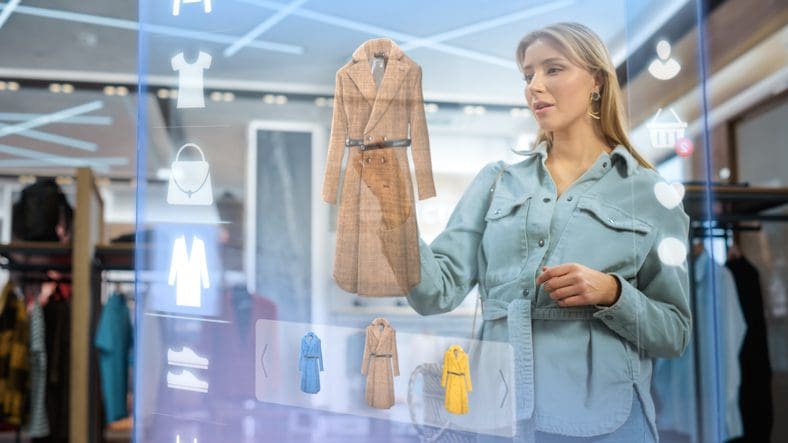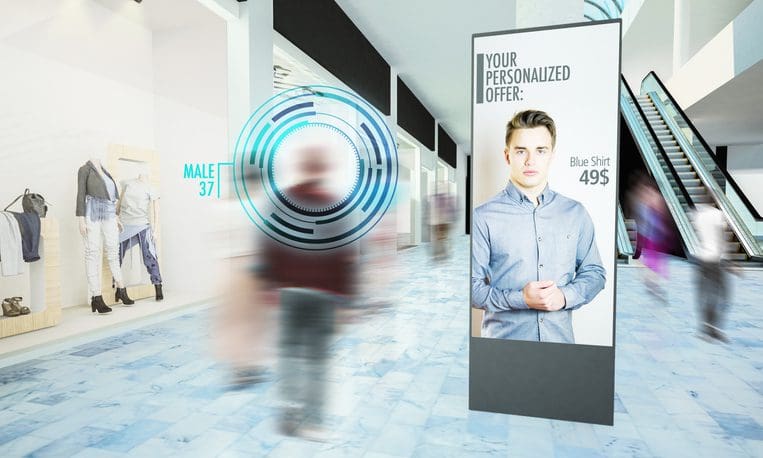July 28, 2021
Maximizing Digital Transformation in Retail: 5 Strategies
READ TIME: 8 MINS
Swift product development and delivery have long been a top priority in retail. However, recent developments have ushered in a new era, accelerating the realization of the benefits of digital transformation in retail.
Retailers need to embrace agility and responsiveness to seize the opportunities presented by rapidly evolving trends. They must do so quickly to avoid falling behind digitally advanced competitors. This necessitates moving beyond isolated process enhancements or technology upgrades and embracing more substantial and ambitious digital transformation strategies 1.
As we navigate toward a digitally native world, brands, and retail businesses can align their strategies around five key pillars. These pillars have been identified through extensive discussions with C-Suite Executives from leading global brands and retailers and insights from respected global analyst firms.
Each pillar offers a rapid return on investment when approached as an independent project. However, they form a roadmap to guide the transition from traditional methods to cutting-edge digital practices. This approach empowers brands and retailers to work at digital speed with confidence.
As the fashion industry deals with mounting performance pressures, shifting consumer behaviors, and surging digital demands, decisive action is imperative to prepare for the ‘next normal.
- The State of Fashion 2021, McKinsey & Company
So, what are these five defining pillars of working@digitalspeed, and how can brands and retailers leverage them to realize the benefits of digital transformation in the retail sector? What actionable visions can drive post-pandemic growth and success in this new era?
Benefits of Digital Transformation in Retail: Map to Work@DigitalSpeed!
1. Seamless Bi-Directional Data Capture and Flow, From Planning to Selling
In retail digital transformation and the benefits of digital transformation, achieving product design and development quickly requires gathering data from various sources – upstream and downstream.
These sources encompass planning systems, supply chain partners, retail channels, and customer interactions. At the core of this digital acceleration lies a comprehensive retail-focused product lifecycle management (PLM) platform that offers end-to-end data management, collaboration, tracking, and reporting capabilities.
It’s crucial that your PLM solution excels in aggregating this data and makes it accessible across the entire spectrum of in-house and supply chain roles. This accessibility fosters swifter, more precise decision-making by presenting a unified source of truth.
In retail digital transformation and the benefits of digital transformation, achieving product design and development quickly requires gathering data from various sources – upstream and downstream. These sources encompass planning systems, supply chain partners, retail channels, and customer interactions. At the core of this digital acceleration lies a comprehensive retail-focused product lifecycle management (PLM) platform that offers end-to-end data management, collaboration, tracking, and reporting capabilities.
It’s crucial that your PLM solution excels in aggregating this data and makes it accessible across the entire spectrum of in-house and supply chain roles. This accessibility fosters swifter, more precise decision-making by presenting a unified source of truth.
To streamline the data capture process, an efficient middleware solution should seamlessly connect diverse enterprise systems and establish a pathway for consolidating outputs from both creative and commercial solutions. The result? Expedited time-to-market, enhanced product quality, and robust collaboration and accountability throughout the value chain.
Mark Harrop, CEO of WhichPLM, aptly emphasizes, “PLM serves as the foundation for a comprehensive digital ecosystem, allowing brands to connect the dots from concept to consumer.”
2. Network Engagement for Early Insights to Understand and Predict Consumer Profiles and Trends.
In the era of eCommerce and the expanding digital landscape, retailers and brands must adapt swiftly to ever-evolving trends and cultivate stronger connections with their customers. Data-driven insights, not mere intuition, should drive this transformation. A recent survey of over 1,000 consumers has underscored the substantial benefits of investing in the infrastructure required for brands to collect and utilize this data: more than 75% of shoppers prefer to purchase from brands they connect with rather than opting for competitors.
To stay ahead in this dynamic environment, your Product Lifecycle Management (PLM) system should be able to integrate with leading social platforms. This integration empowers your design team to draw inspiration directly from the source and tap into real-time consumer sentiment, enabling the creation of trend-responsive products.
Capturing customer feedback early in the design process is crucial for enhancing full-price sell-through and reducing the reliance on markdowns. You can make predictive recommendations to inform design and forecasting decisions by harnessing trend and consumer data. For instance, leveraging AI and machine learning can forecast how incorporating a trend could optimize sell-through rates and boost profit margins.
When it’s time to implement these ideas, a PLM solution that supports channel and geography-specific planning is invaluable. This capability enables retailers to source efficiently, target different markets, and reduce operational costs.
3. A Connected and Integrated Global Supply Chain Providing Visibility and Agility to Support Key Goals.
In today’s retail landscape, it’s essential to have in-depth insights into sourcing, production, and distribution processes to meet the demands of the modern market. Real-time collaboration and accountability play a pivotal role, offering early visibility into potential risks that could impact your delivery schedules, costs, or product quality.
A recent McKinsey report titled “The Future of Retail Supply Chains” underscores the importance of:
“…achieving swift, cost-effective deliveries that consumers demand necessitates retailers having a unified view of their supply chain, showing real-time availability at every point and channel at any time.”
From real-time sharing of technical specifications to minimize errors and eliminate misinterpretations to the collaborative creation of new styles using secure vendor profiles, a top-tier PLM solution can provide a comprehensive overview of all supply chain activities. This empowers you to identify bottlenecks and make informed decisions during the design and development phases.
A critical element of a well-optimized supply chain is sustainability. Since the global fashion industry accounts for 10% of worldwide carbon emissions, sustainability has become a top priority for brands and retailers, evolving into a critical corporate initiative. According to McKinsey’s latest “State of Fashion” report, sustainability is now the second most significant opportunity for the fashion industry, second only to digital transformation.
Consumers are increasingly concerned about sustainability and incorporate it into their purchasing decisions:
“67% of consumers consider sustainable materials important when buying clothes, and 63% evaluate a brand’s sustainability promotion.”
- Vogue
Capturing and analyzing data at production sources, including mills, cut and sew, finishing, and logistics, is vital to empower brands and retailers to implement impactful sustainability initiatives while ensuring the timely and cost-effective delivery of quality products.
4. Data Intelligence and Analytics to Quickly Create Better Products and Business Decisions!
Retailers face pervasive risk exposure, such as excess inventory and persistent issues like limited full-price sell-through and steep markdowns.
Brand and retail businesses can make smarter and more informed decisions by amalgamating the advantages of digital transformation, data utilization, and a collaborative platform like PLM bolstered by advanced machine learning and artificial intelligence. This, in turn, leads to reduced expenses, enhanced collaboration, quicker time to market, and improved sell-through rates.
Jon Duke, Vice President of Research at IDC Retail Insights, emphasizes the potential of artificial intelligence in the modern retail landscape:
“The scale, speed, complexity, and consumer orientation of modern retail create conditions ripe for artificial intelligence… when combined with rapidly shifting consumer preferences and a competitive market filled with new digital-native entrants, it presents an opportunity for forward-thinking retailers to deploy AI solutions to gain a unique competitive advantage strategically.”
Taking cost management as an example, by harnessing the technologies mentioned earlier, brands and retailers can optimize cost strategies and mitigate risk exposure. They gain early and continuous visibility into all cost factors, encompassing material utilization, labor, distribution, and various product variations. Additionally, the ability to simulate cost scenarios much earlier in the product creation process ensures that new products and collections align with financial targets, ultimately boosting profit margins significantly.
Furthermore, data intelligence and analytics empower companies to make better, swifter, and more insightful business decisions. These benefits are exemplified in a recent PLM case study conducted in collaboration with Lacoste, a longstanding retail partner of PTC. This case study showcases how data-driven technology from PTC has been instrumental in fueling the digital transformation of retail, enabling companies to achieve improved outcomes across various facets of their operations.
5. Leverage 3D Experiences Up and Downstream from Shift to Selling Products Before They Are Mass Produced: Design, Sell, Create.
Digital transformation offers crucial advantages within the retail sector, especially concerning digital product creation. It has evolved into a top-priority investment for businesses of all sizes, primarily due to its immediate benefits: enhanced speed to market, superior product quality, improved fit, and strengthened collaboration with customers and suppliers.
Brand and retail enterprises can drive informed decision-making by harnessing data synergy alongside a collaborative platform, such as PLM, integrated with advanced machine learning and artificial intelligence. This approach reduces costs, streamlines collaboration, accelerates time to market and improves market penetration.
A compelling statistic underscores the significance of this digital shift:
“Over 90% of brand and retail leaders believe that the pandemic accelerated the need for digital product creation.”
- Kalypso’s Annual Survey on Digital Product Creation Maturity in Retail Footwear & Apparel
The adoption of 3D technology has surged, especially in response to the pandemic’s challenges. Most brands and retailers have incorporated a 3D strategy as a cornerstone of their digital transformation efforts.
To fully unlock the potential of data and 3D assets, a bi-directional integration between 3D and PLM is essential. The key benefits include expedited time-to-market, reduced costs, and minimized sustainability impacts from multiple sample iterations. Embracing a truly digital process creates digital twins for products, enabling improved engagement with digital consumers and establishing channels for visual communication with suppliers and wholesale customers.
It’s paramount that your PLM solution offers seamless, two-way integrations with leading 3D design and simulation tools. This empowers your users to leverage virtual samples for rapid ideation, streamlined line reviews, and efficient approvals. These same 3D assets can also be employed in augmented reality, merchandise planning, B2B relationships, and e-commerce visualization scenarios.
Businesses that excel in these five critical areas can consider themselves as operating at “digital speed.” It’s remarkable to witness the advancements made by retail customers through PTC’s technology solutions and our international team of retail experts.
If your business is currently reassessing processes, exploring the replacement of legacy technologies, or contemplating strategies to match the market’s rapid pace, we are eager to engage in further discussions. Discover how our vision can empower your digital success strategy and help you remain at the forefront of the industry’s digital transformation. Don’t hesitate to reach out; we look forward to the opportunity to assist you.
Benefits of Digital Transformation Summary
Leveraging the benefits of digital transformation is important in the retail industry to stay competitive and operate at digital speed. Choosing the right PLM solution to meet your business requirements should be addressed. TriStar PLM Solutions has a 25-year track record of assisting companies in achieving precisely that.
If you have inquiries about our solutions or seek more information on how we can support your retail business, please feel free to contact us using the contact information provided below. Don’t hesitate to reach out—we’re here to help you succeed.
1Statistics from EINNews.com. Article on “Retail Digital Transformation Market 2022 Global Analysis, Opportunities, and Forecast To 2028”
Links to Other Pages
- PLM Implementation: Discover strategies for PLM implementation that streamline processes and help with organizational efficiency.
- Windchill BOM Management: Optimize your bill of materials management with Windchill, enhancing accuracy and collaboration.
- Digital Engineering Transformation – Product Development: The impact of digital engineering transformation on product development, innovation, and time to market.
- Overcoming PLM Implementation Challenges with Windchill: Windchill can handle common PLM implementation challenges, transition, and better adoption in this webinar.
- BOM Analysis – Benefits of Digital Transformation: See the benefits of BOM analysis within digital transformation. This analysis provides insights that enhance product management and efficiency.
TriStar Digital Thread Solutions welcomes questions. Feel free to CONTACT US if you can’t find what you’re looking for, or call us at 800-800-1714













Leave A Comment